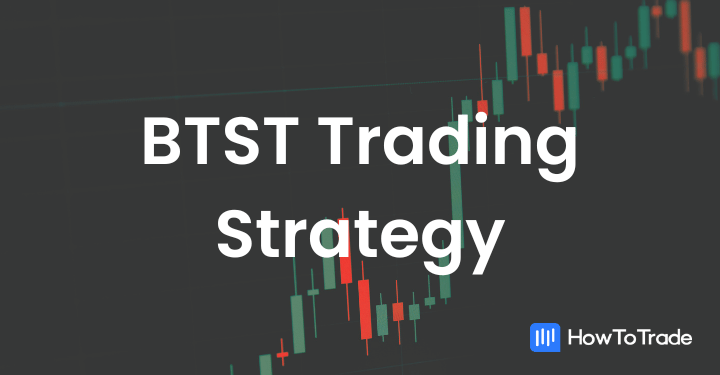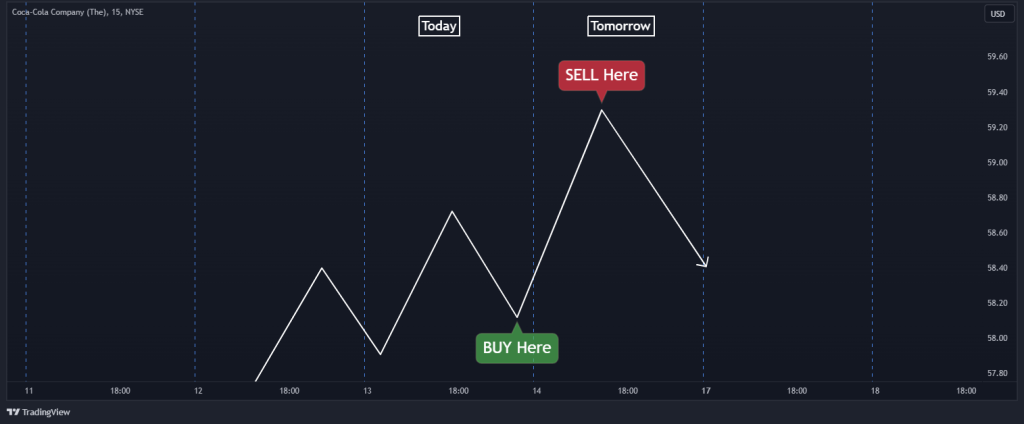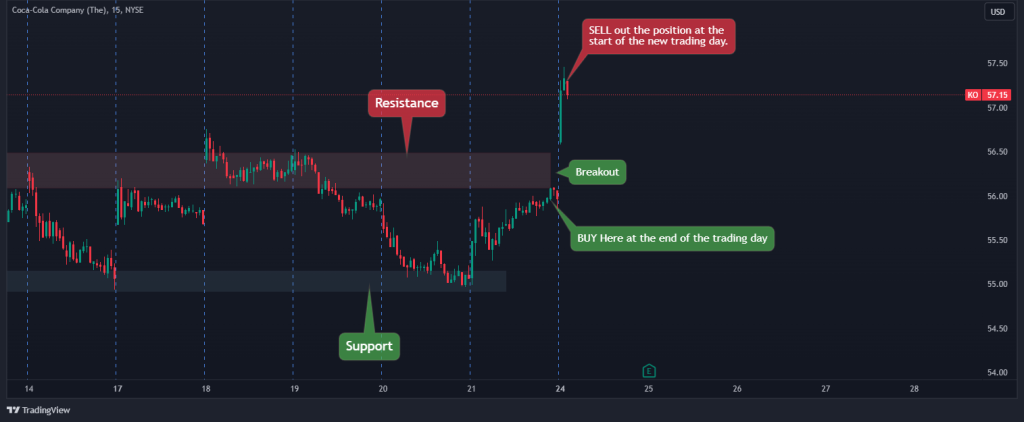
- BTST (Buy Today, Sell Tomorrow) is a short-term trading approach where investors buy shares and aim to sell them the next day, exploiting short-term price movements for profit.
- BTST involves buying stocks and selling them the next day, used when a stock price increase is expected, whereas its opposite version, STBT, is selling stocks today and buying them back the next day, used when a price decrease is anticipated.
- It’s advisable to avoid BTST trading during major economic/political events, when chasing margin benefits, or when trading in less liquid stocks due to increased risks.
- While BTST can be profitable by capitalizing on short-term market movements, it carries risks like penalties for non-receipt of shares and requires careful stock selection and market monitoring.
BTST, which stands for Buy Today, Sell Tomorrow, is a common trading method by which traders exploit overnight changes in various securities that trade on exchanges. It is a fairly simple strategy, although it comes with risks and requires a deep understanding of factors and elements that one must know before deploying it.
In this article, we’ll walk you through what BTST is all about, its ups and downs, and how you can make it work for you.
 Table of Contents
Table of Contents
- What is BTST Strategy and How Does It Work?
- What is the Difference Between BTST and STBT in Intraday Trading?
- When Should You Avoid Doing BTST Trading?
- How to Avoid STT and Short Delivery Issues While Doing BTST Stock Trading?
- How to Use the BTST Strategy?
- What are the Benefits and Limitations of the BTST Strategy?
- Is BTST Trading Profitable?
- Frequently Asked Questions
What is BTST Strategy?
BTST stands for “Buy Today, Sell Tomorrow”. This trading strategy is a straightforward yet effective approach in the stock market and futures market. It operates on a basic principle: investors purchase shares on one day and aim to sell them the next day, capitalizing on short-term price movements for potential profit.
The BTST strategy is particularly tailored to leverage overnight price differences in the stock market, allowing traders to take advantage of short-term volatility.

A key aspect of the BTST strategy is its flexibility regarding the actual possession of shares. Typically, when shares are bought or sold, it takes a couple of days (T+2 days) for these transactions to be reflected in the investor’s brokerage account.
However, in BTST trading, investors can sell the shares they have acquired even before these shares are credited to their brokerage account. This means that they can effectively execute a sell order before the shares are formally deposited in their account. Generally, this can only be done in certain investment accounts, including CFDs (Contract for Difference).
This approach is different from traditional stock holding strategies, where investors hold onto stocks for a longer period. BTST trading strategies are more aligned with short-term investment strategies and are particularly appealing to those looking to make quick profits without the commitment of long-term investment. In essence, the idea is to ride on the momentum of a trading day, with the assumption that the asset’s price will continue to trade in the same direction the following day.
What is the Difference Between BTST and STBT in Intraday Trading?
In the BTST strategy, traders buy stocks today and sell them tomorrow or the next trading day. This approach is typically used when traders expect the stock price to rise by the next day. It allows a one-day holding period, offering a short-term opportunity to capitalize on expected price movements.
BTST trades are often based on fundamental or technical analysis and can be executed in cash or futures & options (F&O) segments. However, it’s important to note that while BTST allows for the next-day sale, intraday trading requires selling on the same day. Also, BTST does not provide additional margins or leverage and carries a higher risk of non-delivery from the seller. Therefore, the requirements of such an account are different than those of an intraday trading account and often involve a higher investment.
However, once you decide to utilize this strategy, you can also use the opposite version – STBT (Sell Today, Buy Tomorrow). Opposite from BTST, STBT involves selling the stock today and buying it back the next day. This strategy is used when the trader expects the stock price to decline by the next day.
It’s mainly applied in the futures & options segment because short selling is not often allowed in the equity segment for overnight trades. The idea is to profit from the expected decrease in the stock’s price. Like BTST, STBT trading is based on market analysis and predictions of price movements.
Here is a table highlighting the differences between BTST (Buy Today, Sell Tomorrow) and STBT (Sell Today, Buy Tomorrow):
| BTST (Buy Today, Sell Tomorrow) | STBT (Sell Today, Buy Tomorrow) |
| Buy stocks today and sell them tomorrow. | Sell stock today and buy it back the next day. |
| Capitalize on the expected price increase the next day. | Profit from expected price decrease the next day. |
| Cash or F&O segment. | Only F&O segment (short selling not allowed in equity segment). |
| Higher risk of non-delivery. | Risks associated with short selling and market volatility. |
| No additional margin or leverage. | Typically higher margins are due to leverage in F&O. |
When Should You Avoid Doing BTST Trading?
While BTST (Buy Today, Sell Tomorrow) trading can be an attractive strategy for quick gains, there are certain situations when it might be prudent to avoid this approach:
1. Absence of Margin Benefit
BTST trading does not typically offer margin benefits, as these are cash and carry orders requiring full payment upfront. This contrasts with intraday trading, where brokers often provide significant margins. Therefore, if you’re looking for leverage through margins, BTST might not be the best strategy. A good solution can be CFDs, which require a fairly low amount of investment but do carry a high level of risk.
2. Risk of Short Delivery
A significant risk associated with BTST is short delivery. This occurs when the seller fails to deliver the shares you bought, leading to an auction of the shares at a possible penalty. If you sell these shares the next day and the original seller fails to deliver, you might also be unable to deliver, resulting in penalties. It’s advisable to be cautious of this risk, especially in less liquid stocks.
3. Choosing Highly Liquid Stocks
For BTST trading, it’s advisable to trade in highly liquid stocks, like large-cap or index-based stocks. These stocks are traded in large volumes daily, reducing the risk of short delivery. Limiting your focus to a few stocks at a time can also enhance your ability to monitor and respond to market changes effectively.
4. Avoiding Pre-Major Event Investments
Contrary to general advice, it might be wise to avoid BTST trading just before major events like company results days, policy declarations, or elections. Although these events can work to your benefit as they cause short-term spikes in stock prices, they also bring unpredictability and higher risks.
BTST trading is more aligned with short-term investment strategies and is particularly appealing to those looking to make quick profits without the commitment of long-term investment.
How to Avoid STT and Short Delivery Issues While Doing BTST Stock Trading?
If you’re looking to trade the BTST strategy effectively, it’s important to understand and mitigate the risks of two key issues – short delivery and Securities Transaction Tax (STT). Let’s quickly explore these:
Understanding Short Delivery in BTST
In BTST trading, you are selling shares that are not yet credited to your brokerage account, relying on the initial seller to deliver these shares. If they fail to do so (short delivery), you face the risk of not being able to meet your selling obligation, leading to potential auction penalties of up to 20% of the stock. This is crucial, and you, therefore, must check your account’s terms with your brokerage firm.
While it’s difficult to predict or control the actions of the seller, you can minimize risk by selecting highly liquid and reliable stocks.
Managing Securities Transaction Tax (STT) in BTST
Another critical issue is STT (Securities Transaction Tax). STT is a tax levied on every stock market transaction. In BTST trades, the STT rate can vary significantly based on whether the transaction is classified as a delivery-based trade or an intraday trade.
To manage STT costs, it’s crucial to understand the STT implications of your trades. For instance, selling shares on the same day as purchase classifies the trade as intraday, attracting lower STT compared to delivery-based trades. Hence, if your BTST trade aligns more with intraday parameters, you might benefit from reduced STT. However, the specific STT rate depends on the nature of the transaction and prevailing regulations, which can change over time. It’s recommended to stay updated with the latest tax regulations in your country or consult a financial expert for precise calculations.
How to Use the BTST Strategy?
Using the BTST (Buy Today, Sell Tomorrow) strategy effectively in trading requires a combination of strategic planning and timely execution. This method is a short-term trading opportunity where a trader purchases shares either in cash or futures and options and sells them the next day. The idea is simple – you assume that the market will open higher the next day, and as such, you aim to exploit this overnight price difference.
But, easier said than done. To use the BTST strategy, there are several methods you should keep in mind.
1. Identifying Price Breakouts
Trading breakout is one of the best BTST trading strategies. The primary criteria for BTST is to anticipate when a stock price is likely to surge upwards, hence, using the breakout strategy. For instance, if a stock shows a significant price increase in a short period, it could indicate a potential breakout. This scenario is ideal for BTST, as you can buy the stock today and sell it tomorrow at a higher price, expecting the upward trend to continue.

From the chart above, we can see the Coca-Cola Stock ranging between two key levels. Towards the end of the trading day, we can BUY the stock while expecting a breakout gap the following day.
2. Having a Stop Loss in Place
While BTST can offer attractive returns, it’s crucial to have a risk management strategy, especially a stop-loss order. Remember, when using the BTST strategy, you are exposed to the overnight risk, which means that the stock price can go against you. This mechanism of using a stop-loss order helps limit potential losses if the stock price falls the next day, thereby protecting your investment from significant downturns.
3. Investing Before Major Events
This is one of the reasons why traders use the BTST strategy. They exploit major events to capitalize on short-term gains. While there’s a risk in using this technique, it can also be an opportunity. Key events like company results announcements, policy declarations, or significant corporate news can cause market volatility. Investing in stocks right before such events can be beneficial for BTST, as these events can lead to short-term price rises suitable for this strategy.
4. Using a 15-minute Candle Day Analysis
The 15-minute timeframe is arguably the most efficient when utilizing the BTST strategy. This technique involves marking the high and low on the first 15-minute candle of the trading day to identify support and resistance levels. If the stock price crosses above the resistance line, it might be the right time to buy, and conversely, crossing below the support line might indicate a selling opportunity.
5. Trading in Highly Liquid Stocks
The BTST strategy certainly works better when trading liquid stocks. You should focus on 2-3 highly liquid stocks at a time to better track price movements. Highly liquid stocks, such as large-cap or index-based stocks, are preferred as they can be sold more easily the next day.
6. Booking Profits when Targets are Achieved
Set clear entry and target levels before starting. Once the target price is reached, it’s advisable to book profits and not let greed drive decisions. In cases where there’s potential for further upside, closely monitor the stock and adjust stop losses accordingly.
What are the Benefits and Limitations of the BTST Strategy?
Before you start using the BTST Strategy, it’s important to weigh your options by comparing its advantages and limitations. Here are the most important ones to keep in mind:
Benefits of BTST Trading Strategy
The major benefit of BTST trading is its ability to leverage market volatility within a short span, offering the potential for quick gains. Moreover, since shares are sold before being deposited, DP (Depository Participant) charges, which are generally incurred when shares are held overnight, are avoided, adding to the cost-effectiveness of the strategy.
Pros
- Exploits short-term market volatility.
- Avoids Depository Participant (DP) charges by selling before shares are deposited.
- Offers a fallback option for unprofitable intraday trades.
- Facilitates quick gains in a shorter time frame.
Limitations of BTST Trading Strategy
While BTST trading offers several attractive features, it’s not without its limitations. A significant risk is a potential penalty due to the non-receipt of share delivery on the settlement date, which can lead to a failure in fulfilling the sell order. Additionally, the availability of BTST facilities can be broker-dependent, often leading to variable charges for CNC orders.
Cons
- Risk of penalties due to non-receipt of shares.
- Potential margin penalties for insufficient balance.
- Dependence on broker availability and varying charges.
- Requires careful timing and market monitoring.
Is BTST Trading Profitable?
BTST trading strategy, when executed with precision and understanding, can indeed be profitable. It offers traders an opportunity to capitalize on short-term price movements in the stock and futures market. The key to profitability in BTST trading lies in the strategic selection of stocks, timely execution, and a keen understanding of market trends and dynamics.
The strategy is particularly effective when traders identify securities with a strong potential for price increase the next day, often based on technical or fundamental analysis. Since BTST allows for a holding period of just one day, it minimizes the exposure to long-term market volatility while aiming to take advantage of immediate price movements.
However, it’s crucial to remember that BTST trading is not without its risks. Challenges like the risk of short delivery and the absence of margin benefits require careful consideration. It requires opening a suitable trading account for holding positions overnight and creating the right terms for profitability. One option to do that is via a CFD trading account, where you can buy stocks without having to deal with margin requirements and fees for holding a position overnight. Then, BTST trading can surely be a valuable strategy for generating profits in the market.
Frequently Asked Questions About the BTST Trading Strategy
Here are some of the frequently asked questions about the BTST trading strategy.
What is BTST Trading?
BTST stands for Buy Today, and Sell Tomorrow. It’s a trading strategy where traders purchase shares one day and sell them the next day before the delivery. This strategy allows traders to capitalize on the positive overnight price movement of a stock. It is used by traders to take advantage of short-term market movements without the need to wait for the actual stock delivery.
Which Stocks are allowed for BTST trading?
Generally, most stocks that are traded on major stock exchanges are available for BTST trading. However, the availability can depend on the brokerage firm’s policies and the liquidity of the stock. Typically, highly liquid and large-cap stocks are preferred for BTST trading due to their high trading volume and lower risk of short delivery.
Is there any risk in BTST trading?
Yes, like all trading strategies, BTST trading comes with its set of risks. One of the primary risks is the possibility of short delivery, which occurs when the seller fails to deliver the shares, leading to an auction and potential penalties. Market volatility can also impact BTST trades, especially if unforeseen events affect stock prices overnight. Additionally, since BTST trades do not typically benefit from margin, traders need to have the full amount for the purchase, which may increase the capital requirement.
Risk Disclosure: The information provided in this article is not intended to give financial advice, recommend investments, guarantee profits, or shield you from losses. Our content is only for informational purposes and to help you understand the risks and complexity of these markets by providing objective analysis. Before trading, carefully consider your experience, financial goals, and risk tolerance. Trading involves significant potential for financial loss and isn't suitable for everyone.



